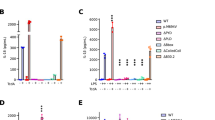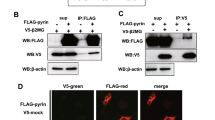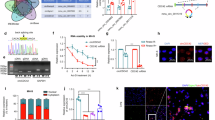Abstract
Cytosolic inflammasome complexes mediated by a pattern recognition receptor (PRR) defend against pathogen infection by activating caspase 1. Pyrin, a candidate PRR, can bind to the inflammasome adaptor ASC to form a caspase 1-activating complex1,2. Mutations in the Pyrin-encoding gene, MEFV, cause a human autoinflammatory disease known as familial Mediterranean fever3,4,5. Despite important roles in immunity and disease, the physiological function of Pyrin remains unknown. Here we show that Pyrin mediates caspase 1 inflammasome activation in response to Rho-glucosylation activity of cytotoxin TcdB6,7,8, a major virulence factor of Clostridium difficile, which causes most cases of nosocomial diarrhoea. The glucosyltransferase-inactive TcdB mutant loses the inflammasome-stimulating activity. Other Rho-inactivating toxins, including FIC-domain adenylyltransferases (Vibrio parahaemolyticus VopS and Histophilus somni IbpA) and Clostridium botulinum ADP-ribosylating C3 toxin, can also biochemically activate the Pyrin inflammasome in their enzymatic activity-dependent manner. These toxins all target the Rho subfamily and modify a switch-I residue. We further demonstrate that Burkholderia cenocepacia inactivates RHOA by deamidating Asn 41, also in the switch-I region, and thereby triggers Pyrin inflammasome activation, both of which require the bacterial type VI secretion system (T6SS). Loss of the Pyrin inflammasome causes elevated intra-macrophage growth of B. cenocepacia and diminished lung inflammation in mice. Thus, Pyrin functions to sense pathogen modification and inactivation of Rho GTPases, representing a new paradigm in mammalian innate immunity.
This is a preview of subscription content, access via your institution
Access options
Subscribe to this journal
Receive 51 print issues and online access
$199.00 per year
only $3.90 per issue
Buy this article
- Purchase on SpringerLink
- Instant access to full article PDF
Prices may be subject to local taxes which are calculated during checkout





Similar content being viewed by others
References
Seshadri, S., Duncan, M. D., Hart, J. M., Gavrilin, M. A. & Wewers, M. D. Pyrin levels in human monocytes and monocyte-derived macrophages regulate IL-1β processing and release. J. Immunol. 179, 1274–1281 (2007)
Yu, J. W. et al. Cryopyrin and pyrin activate caspase-1, but not NF-κB, via ASC oligomerization. Cell Death Differ. 13, 236–249 (2006)
French FMF Consortium A candidate gene for familial Mediterranean fever. Nature Genet. 17, 25–31 (1997)
The International FMF Consortium Ancient missense mutations in a new member of the RoRet gene family are likely to cause familial Mediterranean fever. Cell 90, 797–807 (1997)
Chae, J. J. et al. Gain-of-function Pyrin mutations induce NLRP3 protein-independent interleukin-1β activation and severe autoinflammation in mice. Immunity 34, 755–768 (2011)
Jank, T. & Aktories, K. Structure and mode of action of clostridial glucosylating toxins: the ABCD model. Trends Microbiol. 16, 222–229 (2008)
Kuehne, S. A. et al. The role of toxin A and toxin B in Clostridium difficile infection. Nature 467, 711–713 (2010)
Lyras, D. et al. Toxin B is essential for virulence of Clostridium difficile. Nature 458, 1176–1179 (2009)
Kayagaki, N. et al. Non-canonical inflammasome activation targets caspase-11. Nature 479, 117–121 (2011)
Ng, J. et al. Clostridium difficile toxin-induced inflammation and intestinal injury are mediated by the inflammasome. Gastroenterology 139, 542–552.e1–3 (2010)
Keestra, A. M. et al. Manipulation of small Rho GTPases is a pathogen-induced process detected by NOD1. Nature 496, 233–237 (2013)
Fukazawa, A. et al. GEF-H1 mediated control of NOD1 dependent NF-κB activation by Shigella effectors. PLoS Pathog. 4, e1000228 (2008)
Richards, N. et al. Interaction between pyrin and the apoptotic speck protein (ASC) modulates ASC-induced apoptosis. J. Biol. Chem. 276, 39320–39329 (2001)
Cordero, C. L., Kudryashov, D. S., Reisler, E. & Satchell, K. J. The actin cross-linking domain of the Vibrio cholerae RTX toxin directly catalyzes the covalent cross-linking of actin. J. Biol. Chem. 281, 32366–32374 (2006)
Sheahan, K. L. & Satchell, K. J. Inactivation of small Rho GTPases by the multifunctional RTX toxin from Vibrio cholerae. Cell. Microbiol. 9, 1324–1335 (2007)
Aktories, K. Bacterial protein toxins that modify host regulatory GTPases. Nature Rev. Microbiol. 9, 487–498 (2011)
Yarbrough, M. L. et al. AMPylation of Rho GTPases by Vibrio VopS disrupts effector binding and downstream signaling. Science 323, 269–272 (2009)
Mattoo, S. et al. Comparative analysis of Histophilus somni immunoglobulin-binding protein A (IbpA) with other fic domain-containing enzymes reveals differences in substrate and nucleotide specificities. J. Biol. Chem. 286, 32834–32842 (2011)
Worby, C. A. et al. The fic domain: regulation of cell signaling by adenylylation. Mol. Cell 34, 93–103 (2009)
Popoff, M. R. et al. Ras, Rap, and Rac small GTP-binding proteins are targets for Clostridium sordellii lethal toxin glucosylation. J. Biol. Chem. 271, 10217–10224 (1996)
Just, I., Selzer, J., Hofmann, F., Green, G. A. & Aktories, K. Inactivation of Ras by Clostridium sordellii lethal toxin-catalyzed glucosylation. J. Biol. Chem. 271, 10149–10153 (1996)
Aktories, K. & Hall, A. Botulinum ADP-ribosyltransferase C3: a new tool to study low molecular weight GTP-binding proteins. Trends Pharmacol. Sci. 10, 415–418 (1989)
Jank, T., Giesemann, T. & Aktories, K. Clostridium difficile glucosyltransferase toxin B-essential amino acids for substrate binding. J. Biol. Chem. 282, 35222–35231 (2007)
Boyer, L. et al. Pathogen-derived effectors trigger protective immunity via activation of the Rac2 enzyme and the IMD or Rip kinase signaling pathway. Immunity 35, 536–549 (2011)
Bruno, V. M. et al. Salmonella Typhimurium type III secretion effectors stimulate innate immune responses in cultured epithelial cells. PLoS Pathog. 5, e1000538 (2009)
Flannagan, R. S. et al. Burkholderia cenocepacia disrupts host cell actin cytoskeleton by inactivating Rac and Cdc42. Cell. Microbiol. 14, 239–254 (2012)
Rosales-Reyes, R., Skeldon, A. M., Aubert, D. F. & Valvano, M. A. The Type VI secretion system of Burkholderia cenocepacia affects multiple Rho family GTPases disrupting the actin cytoskeleton and the assembly of NADPH oxidase complex in macrophages. Cell. Microbiol. 14, 255–273 (2012)
Gavrilin, M. A. et al. Activation of the pyrin inflammasome by intracellular Burkholderia cenocepacia. J. Immunol. 188, 3469–3477 (2012)
Waite, A. L. et al. Pyrin and ASC co-localize to cellular sites that are rich in polymerizing actin. Exp. Biol. Med. (Maywood) 234, 40–52 (2009)
Jones, J. D. & Dangl, J. L. The plant immune system. Nature 444, 323–329 (2006)
Gong, Y. N. et al. Chemical probing reveals insights into the signaling mechanism of inflammasome activation. Cell Res. 20, 1289–1305 (2010)
Zhao, Y. et al. The NLRC4 inflammasome receptors for bacterial flagellin and type III secretion apparatus. Nature 477, 596–600 (2011)
Yang, G. et al. Expression of recombinant Clostridium difficile toxin A and B in Bacillus megaterium. BMC Microbiol. 8, 192 (2008)
Yang, J., Zhao, Y., Shi, J. & Shao, F. Human NAIP and mouse NAIP1 recognize bacterial type III secretion needle protein for inflammasome activation. Proc. Natl Acad. Sci. USA 110, 14408–14413 (2013)
Benard, V., Bohl, B. P. & Bokoch, G. M. Characterization of Rac and Cdc42 activation in chemoattractant-stimulated human neutrophils using a novel assay for active GTPases. J. Biol. Chem. 274, 13198–13204 (1999)
Ren, X. D. & Schwartz, M. A. Determination of GTP loading on Rho. Methods Enzymol. 325, 264–272 (2000)
Cermak, T. et al. Efficient design and assembly of custom TALEN and other TAL effector-based constructs for DNA targeting. Nucleic Acids Res. 39, e82 (2011)
Higa, N. et al. Vibrio parahaemolyticus effector proteins suppress inflammasome activation by interfering with host autophagy signaling. PLoS Pathog. 9, e1003142 (2013)
Flannagan, R. S., Linn, T. & Valvano, M. A. A system for the construction of targeted unmarked gene deletions in the genus Burkholderia. Environ. Microbiol. 10, 1652–1660 (2008)
Acknowledgements
We thank V. Dixit for providing knockout mice and anti-ASC antibody, D. Lyras for C. sordellii genomic DNA, J. Xiao for IbpA-Fic constructs, T. Iida for V. parahaemolyticus strain, M. Valvano for pDAI-SceI vector and H. Feng for TcdB B. megaterium expression system. We thank members of the Shao laboratory for discussions. The research was supported in part by an International Early Career Scientist grant from the Howard Hughes Medical Institute to F.S. This work was also supported by the National Basic Research Program of China 973 Program (2012CB518700), the Strategic Priority Research Program of the Chinese Academy of Sciences (XDB08020202) and China National Science Foundation Program for Distinguished Young Scholars (31225002) to F.S.
Author information
Authors and Affiliations
Contributions
F.S. conceived the study; H.X. and J.Y. performed the majority of experiments, assisted by W.G.; L.L., P.L., L.Z., Y.-N.G., X.P., J.J.X., S.C. and F.W. contributed reagents and analytic tools. H.X., J.Y. and F.S. analysed the data and wrote the manuscript. All authors discussed the results and commented on the manuscript.
Corresponding author
Ethics declarations
Competing interests
The authors declare no competing financial interests.
Extended data figures and tables
Extended Data Figure 1 TcdB-induced caspase 1 inflammasome activation in various mouse BMDMs.
a–d, BMDMs from wild-type (WT, C57BL/6) or indicated knockout mice were left untreated (cont) or stimulated with TcdB, TcsL or EprI for 2.5 to 3 h. EprI was delivered by the LFn-PA system. e–g, Wild-type or Nod1−/− BMDMs (C57BL/6 background) or Nod1−/− BMDMs transfected with Nod2-specific siRNAs (Nod2-1 and Nod-2) or control siRNA were stimulated TcdB as indicated. The knockdown efficiency were measured by qRT–PCR analyses in f (n = 3; mean ± s.d.). h, BMDMs from different mouse inbred strains were stimulated with TcdB. TcdBm and TcsLm denote the glucosyltransferase-deficient TcdB(W102A/D288N) and TcsL(D286N/D288N) mutants, respectively. Macrophage supernatants were collected for anti-caspase 1 immunoblotting analyses in a, e, g and h (representative of at least three repetitions). ELISA assay of IL-1β release in LPS-primed BMDMs is shown in d and percentages of cell death measured by LDH (lactate dehydrogenase) release are in b, c (n = 3; mean ± s.d.).
Extended Data Figure 2 Cell rounding induced by Rho-modifying toxins and effectors.
Caspase 1−/− BMDMs were left untreated (control) or stimulated with large clostridial glucosylating cytotoxins TcdB/TcsL in a and FIC-domain bacterial effectors (VopS and IbpA-Fic1/2) in b. TcdBm and TcsLm denote the corresponding catalytically inactive mutants. VopS, IbpA-Fic1 and IbpA-Fic2 (WT or the catalytically inactive H/A mutants) were delivered into BMDMs using the LFn-PA system. Representative differential interference contrast (DIC) microscopy images of cell morphology are shown.
Extended Data Figure 3 TcdB-induced caspase 1 inflammasome activation in Pyrin-complemented DC2.4 cells and human monocyte-derived macrophages.
a–c, DC2.4 cells harbouring a vector (DC2.4+Vec), mouse Pyrin isoform 1 (DC2.4+mPyrin-iso1), mouse Pyrin isoform 2 (DC2.4+mPyrin-iso2), human Pyrin isoform 1 (DC2.4+hPyrin-iso1) or NLRP3 were stimulated with TcdB or as indicated. d–f, Phorbol-12-myristate-13-acetate (PMA)-differentiated THP-1 or U937 cells (harbouring a vector or human Pyrin isoform 1) were stimulated with TcdB or MxiH. g, qRT–PCR measurements of relative Pyrin expression level (normalized to that of GAPDH) (n = 3; mean ± s.d.). h, DC2.4 cells stably expressing eGFP–Pyrin were stimulated with TcdB or poly(dA:dT), and then subjected to anti-ASC immunofluorescence staining. DAPI stains the nuclei. The merged images show the co-aggregation of eGFP–Pyrin with endogenous ASC. Representative caspase 1 immunoblots from at least three repetitions are shown in c and d. ELISA assay of IL-1β release in a and percentages of cell death measured by LDH release in b, e and f are mean ± s.d. (n = 3).
Extended Data Figure 4 TALEN-mediated Mefv knockout in mice and its effect on TcdB-induced caspase 1 activation.
a, The design of Mefv-targeting TALEN. b, The sequence mutations for the five homozygous F1 lines used in the study. F1-1, 3 and 4 were obtained by intercross of two heterozygous founders bearing different frameshift alleles. F1-2 and 5 were crossed from another two heterozygous founders harbouring the same frameshift allele. c, BMDMs from Mefv−/− F1-3 and F1-4 mice were stimulated with TcdB or TcdBm. Shown are representative caspase 1 immunoblots from at least three repetitions.
Extended Data Figure 5 Toxins-induced modification of Rho GTPases and Rho inactivation by TcdB, TcsL, C3 and B. cenocepacia infection.
a, Lysates of TcdB or TcsL-treated Caspase 1−/− BMDM cells were subjected to in vitro ADP-ribosylation reaction by purified C3 toxin. Anti-RHOA immunoblotting shows TcdB modification of RHOA, as suggested by its resistance to further modification by the C3 toxin. b, c, e, DC2.4 cells were stimulated with TcdB, TcsL or LFn-tagged C3 toxin in b, c, or infected with B. cenocepacia (WT or the Δhcp mutant) in e. Cell lysates were subjected to glutathione S-transferase (GST)–RBD (the Rho binding domain of human Rhotekin protein) (b, e) and GST-PBD (the Rac/Cdc42 (p21) binding domain of human p21 activated kinase 1 protein (c, e) pulldown assays to measure GTP-bound RHOA and Rac/Cdc42, respectively. d, Caspase 1−/− BMDMs were delivered with V. parahaemolyticus VopS and the two FIC domains in H. somni IbpA (IbpA-Fic1/2) by the LFn-PA system. H/A, mutation of the FIC-domain catalytic histidine. Anti-RHOA immunoblotting shows the SDS–PAGE mobility shift of RHOA as a result of effector-catalysed adenylylation. Data in all panels are representative of at least three repetitions.
Extended Data Figure 6 Actin polymerization-inhibiting agents and the RID domain of Vibrio RTX toxin cannot activate caspase 1 inflammasome.
a, b, Primary BMDMs were left untreated (control), treated with cytochalasin D (Cyto D) or delivered with LFn-tagged actin crosslinking domain (ACD) from Vibrio RTX toxin. c–e, Primary BMDMs or Pyrin-complemented DC2.4 or 293T cells were stimulated with LFn-tagged RID domain from V. cholerae RTX toxin or TcdB. Representative DIC microscopy images of cell morphology are shown in a. Caspase 1 immunoblots are shown in b and c; percentages of cell death measured by LDH release are in d (n = 3; mean ± s.d.). Fluorescence images of RFP–ASC stably expressed in 293T cells are presented in e. Data in all panels are representative of at least three repetitions.
Extended Data Figure 7 Pyrin inflammasome activation by FIC-domain Rho-adenylylating effectors.
a, b, Effects of Nlrp3, Nlrc4 and Asc knockout on inflammasome activation by FIC-domain Rho-adenylylating effectors. c, d, BMDMs from wild-type mice or two independent Mefv−/− lines (F1-1 and F1-5) were stimulated with various FIC-domain effectors. e, f, Pyrin-complemented DC2.4 cells or primary BMDMs from wild-type or Mefv−/− F1-1 mice were stimulated with indicated toxins or infected with V. parahaemolyticus (V. para) POR3 strain (ΔtdhASΔvcrD2). VopS and IbpA-Fic1/2 were delivered into indicated BMDMs by the LFn-PA system. H/A, mutation of the catalytic histidine. Representative caspase 1 immunoblots from at least three repetitions are shown in a, e and f. ELISA assay of IL-1β release is in b, c, d (n = 3; mean ± s.d.).
Extended Data Figure 8 C3 modification/inactivation of the Rho subfamily induces Pyrin inflammasome activation.
C3 toxin was delivered into indicated BMDMs in a, c–e or DC2.4 cells stably expressing Flag–RHOA/Cdc42 in b by using the LFn-PA system. The SDS–PAGE mobility shift in anti-RHOA/Cdc42 immunoblots in a shows the specific modification of RHOA by C3. Flag–RHOA/Cdc42 purified from DC2.4 cells was subjected to TcdB glucosylation in the presence of UDP-[3H]Glucose. 3H-autoradiograph and anti-Flag immunoblot in b show that C3 stimulation blocks TcdB modification of RHOA but not Cdc42. Caspase 1 immunoblots are shown in c; ELISA assay of IL-1β release in LPS-primed BMDMs is in d and e (n = 3; mean ± s.d.). Data in all panels are representative of at least three repetitions.
Extended Data Figure 9 Pyrin requires, but does not directly interact with, the Rho subfamily in mediating TcdB-induced inflammasome activation.
a–d, Effects of siRNA knockdown of RHOA, B and C on TcdB-induced ASC foci formation. 293T cells stably expressing Pyrin and RFP–ASC were transfected with indicated siRNA or siRNA combinations followed by TcdB stimulation. Rhoa-1/2, Rhob-1/2 and Rhoc-1/2 are two independent siRNAs targeting RHOA, B and C, respectively. qRT–PCR analyses of the knockdown efficiency are shown in a, c (n = 3; mean ± s.d.) and percentages of cells showing ASC foci formation are in b, d (n = 3, mean ± s.d.; P value, Student’s t-test). e, f, Co-immunoprecipitation interaction assays of Pyrin and Rho GTPases. 293T cells were transfected with haemagglutinin (HA)–6myc–PyrinΔN88 (deletion of N-terminal 88 residue.) together with Flag–6myc–PyrinΔN88 or an indicated Rho GTPase construct in e. DC2.4 cells stably expressing Flag–6myc–PyrinΔN88 were left untreated or stimulated with TcdB in f. Immunoblots of anti-Flag immunoprecipitates (Flag IP) and total cell lysates (input) shown in e and f are representative from at least three repetitions.
Extended Data Figure 10 Pyrin senses B. cenocepacia-induced Asn 41 deamidation of RHOA and induces caspase 1 inflammasome activation in the T6SS-dependent manner.
a–e, Wild-type, Nlrp3−/−Nlrc4−/−, Aim2−/−, Asc−/− and Mefv−/− BMDMs were infected with B. cenocepacia J2315 strain (B.c., wild-type or the Δhcp mutant) or S. typhimurium (S.t.) for 3 h at a multiplicity of infection (m.o.i.) of 20:1. f–i, U937 or DC2.4 cells harbouring a vector or expressing human Pyrin (hPyrin) or mouse Pyrin isoform 1 (mPyrin-iso1) were infected with B. cenocepacia (B.c.) (wild type or the Δhcp mutant), S. flexneri (S.f.), EHEC, or stimulated with TcdB as indicated. j, Effects of overexpression of deamidated RHOA on ASC foci formation. The RHOA, B and C triple-knockdown 293T cells obtained in Fig. 4e were transiently transfected with an empty vector or a plasmid overexpressing RHOA wild type or the N41D mutant. Representative caspase 1 immunoblot from at least three repetitions are shown in a, b, e, f, h and i. ELISA assay of IL-1β release in c, d and g and percentages of cells showing the ASC foci in j are mean ± s.d. (n = 3). For j, the P value was determined by Student’s t-test.
Rights and permissions
About this article
Cite this article
Xu, H., Yang, J., Gao, W. et al. Innate immune sensing of bacterial modifications of Rho GTPases by the Pyrin inflammasome. Nature 513, 237–241 (2014). https://doi.org/10.1038/nature13449
Received:
Accepted:
Published:
Issue date:
DOI: https://doi.org/10.1038/nature13449
This article is cited by
-
Recent Insights in Pyrin Inflammasome Activation: Identifying Potential Novel Therapeutic Approaches in Pyrin-Associated Autoinflammatory Syndromes
Journal of Clinical Immunology (2024)
-
Mutations in the B30.2 and the central helical scaffold domains of pyrin differentially affect inflammasome activation
Cell Death & Disease (2023)
-
Integrated NLRP3, AIM2, NLRC4, Pyrin inflammasome activation and assembly drive PANoptosis
Cellular & Molecular Immunology (2023)
-
Inflammasome activity is controlled by ZBTB16-dependent SUMOylation of ASC
Nature Communications (2023)
-
Inflammasomes as regulators of mechano-immunity
EMBO Reports (2023)



